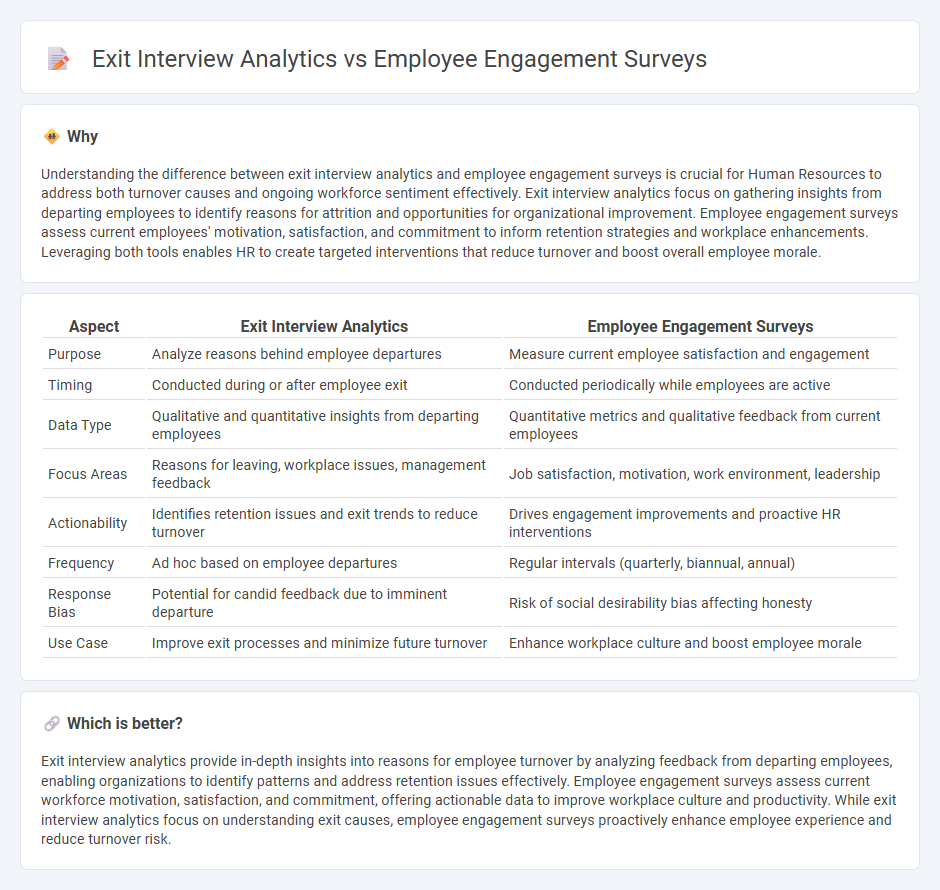
Exit interview analytics provide detailed insights into employee turnover by analyzing reasons for departure and identifying organizational patterns. Employee engagement surveys measure ongoing workforce satisfaction and motivation to enhance retention and productivity. Explore how combining these tools can create a comprehensive human resources strategy.
Why it is important
Understanding the difference between exit interview analytics and employee engagement surveys is crucial for Human Resources to address both turnover causes and ongoing workforce sentiment effectively. Exit interview analytics focus on gathering insights from departing employees to identify reasons for attrition and opportunities for organizational improvement. Employee engagement surveys assess current employees' motivation, satisfaction, and commitment to inform retention strategies and workplace enhancements. Leveraging both tools enables HR to create targeted interventions that reduce turnover and boost overall employee morale.
Comparison Table
| Aspect | Exit Interview Analytics | Employee Engagement Surveys |
|---|---|---|
| Purpose | Analyze reasons behind employee departures | Measure current employee satisfaction and engagement |
| Timing | Conducted during or after employee exit | Conducted periodically while employees are active |
| Data Type | Qualitative and quantitative insights from departing employees | Quantitative metrics and qualitative feedback from current employees |
| Focus Areas | Reasons for leaving, workplace issues, management feedback | Job satisfaction, motivation, work environment, leadership |
| Actionability | Identifies retention issues and exit trends to reduce turnover | Drives engagement improvements and proactive HR interventions |
| Frequency | Ad hoc based on employee departures | Regular intervals (quarterly, biannual, annual) |
| Response Bias | Potential for candid feedback due to imminent departure | Risk of social desirability bias affecting honesty |
| Use Case | Improve exit processes and minimize future turnover | Enhance workplace culture and boost employee morale |
Which is better?
Exit interview analytics provide in-depth insights into reasons for employee turnover by analyzing feedback from departing employees, enabling organizations to identify patterns and address retention issues effectively. Employee engagement surveys assess current workforce motivation, satisfaction, and commitment, offering actionable data to improve workplace culture and productivity. While exit interview analytics focus on understanding exit causes, employee engagement surveys proactively enhance employee experience and reduce turnover risk.
Connection
Exit interview analytics provide critical insights into employee turnover patterns, while employee engagement surveys measure ongoing workforce satisfaction and commitment. Together, these tools identify underlying causes of disengagement and attrition, enabling HR to develop targeted retention strategies. Leveraging data from both sources enhances predictive analytics for improving organizational culture and reducing turnover costs.
Key Terms
**Employee Engagement Surveys:**
Employee engagement surveys provide comprehensive insights into employee satisfaction, motivation, and workplace culture by capturing real-time feedback from a broad workforce. They identify trends in employee well-being, highlight areas for improvement, and drive strategic initiatives to enhance retention and productivity. Discover how leveraging employee engagement surveys can transform organizational performance and foster a positive workplace environment.
Job Satisfaction
Employee engagement surveys provide comprehensive insights into job satisfaction by capturing ongoing feedback from current employees, identifying areas for improvement and fostering a positive work environment. Exit interview analytics offer retrospective data that highlights reasons behind employee turnover and dissatisfaction, revealing patterns that might not be evident in regular surveys. Explore deeper to understand how combining both approaches can enhance overall workforce satisfaction and retention.
Organizational Commitment
Employee engagement surveys measure ongoing organizational commitment by gathering real-time data on employee satisfaction, motivation, and alignment with company values, providing actionable insights to improve retention. Exit interview analytics reveal reasons behind voluntary departures, identifying specific factors influencing declining commitment and uncovering gaps in workplace culture and management practices. Explore how combining these tools enhances strategies to boost organizational commitment and reduce turnover.
Source and External Links
Employee Engagement Surveys: Ultimate Guide - SurveyMonkey - Employee engagement surveys help detect dissatisfied employees, improve company culture, and include tools like the employee Net Promoter Score (eNPS) which measures overall employee satisfaction and likelihood to recommend the company.
Employee Engagement Surveys: The Questions to Ask & Why - Qualtrics - Employee engagement surveys assess employee sentiment, reduce attrition, and should be conducted regularly with questions on workload, career progression, and relationships with managers.
22 employee engagement survey questions you should ask - Culture Amp - Effective surveys measure engagement with multiple questions focusing on pride, recommendation, commitment, and motivation, including the "barbecue test" question on employee pride in the company.
 dowidth.com
dowidth.com